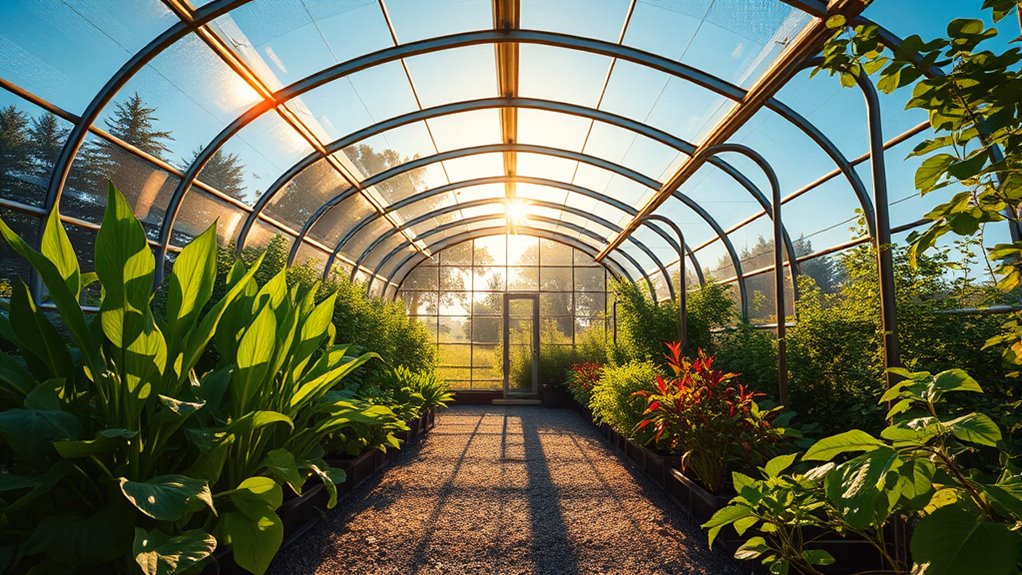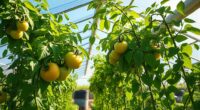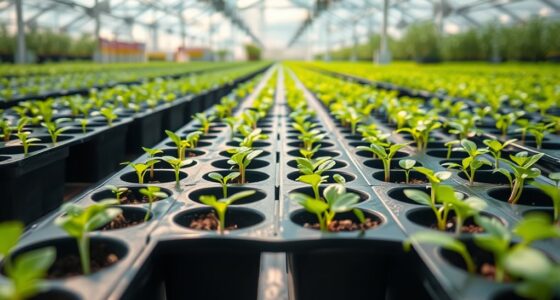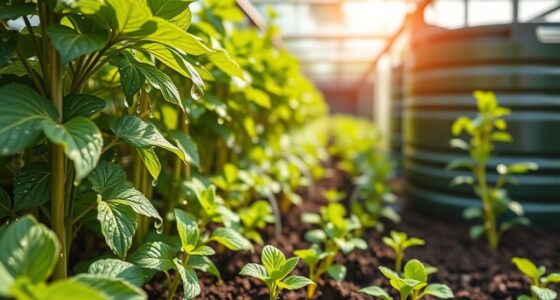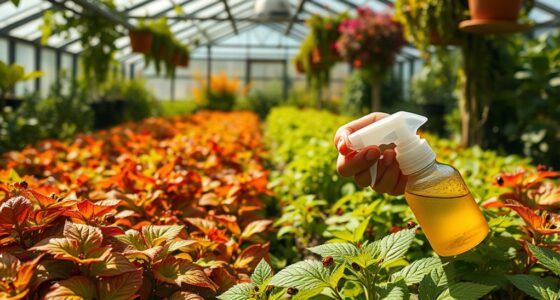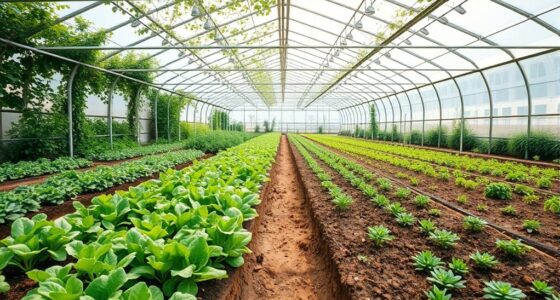To harness sunlight year-round in a passive solar greenhouse, face it south in the northern hemisphere to maximize solar gain. Use thermal mass materials like concrete or water barrels to absorb heat during the day and release it at night. Choose transparent glazing like glass or polycarbonate to let in ample sunlight while insulating effectively. Proper insulation, ventilation, and strategic placement of thermal mass are key. Continue exploring to discover how these elements work together to create a stable, warm environment all year.
Key Takeaways
- Position the greenhouse facing south in the northern hemisphere to maximize solar exposure year-round.
- Incorporate thermal mass materials like concrete or water barrels on the interior’s southern side to absorb and release heat.
- Use high-transparency glazing such as clear glass or polycarbonate panels to optimize sunlight entry and insulation.
- Properly insulate walls and roof to minimize heat loss and maintain stable internal temperatures.
- Include ventilation and automated systems to regulate airflow, preventing overheating and ensuring consistent climate control.

Passive solar greenhouse design harnesses the sun’s energy to naturally heat your greenhouse, reducing reliance on artificial heating systems. To maximize this effect, you need to pay close attention to how you incorporate thermal mass and select glazing materials. Thermal mass acts as a heat reservoir, absorbing sunlight during the day and slowly releasing it at night, helping to maintain a stable temperature inside your greenhouse. You can use materials like concrete, water barrels, or bricks for thermal mass. Placing these mass elements where they receive the most sunlight ensures they absorb and store as much heat as possible during the day.
Choosing the right glazing materials is equally important. These materials determine how much sunlight enters your greenhouse and how effectively heat is retained. Clear or low-iron glass offers high transparency, allowing maximum sunlight to penetrate, but it can sometimes lead to heat loss if not properly insulated. Polycarbonate panels or acrylic plastics also transmit ample light, are lightweight, and provide better insulation than glass, reducing heat loss at night. Insulated glazing options with multiple layers or coatings can further improve heat retention, ensuring your greenhouse stays warm even during colder months.
When designing your passive solar greenhouse, you should orient it to maximize sunlight exposure, typically facing south in the northern hemisphere. This orientation ensures maximum solar gain throughout the day. Incorporate thermal mass on the interior’s southern side, where it can directly absorb sunlight. The placement allows the thermal mass to act as a buffer, releasing stored heat during cooler hours. Additionally, ensure your glazing material has a high solar transmittance, allowing more sunlight to enter while minimizing heat escape.
Proper insulation around the sides and roof is essential to prevent heat from escaping. Use insulation materials that are compatible with your glazing choices, such as foam or reflective barriers, to keep the internal temperature stable. Ventilation is also vital; you need to balance heat retention with airflow to prevent overheating during sunny days. Automated vent openers can help regulate internal temperatures, opening when it gets too warm and closing when it’s cooler.
Frequently Asked Questions
What Are the Initial Costs of Passive Solar Greenhouse Construction?
When you consider the initial costs of passive solar greenhouse construction, you need to focus on cost estimation and material selection. The total expense varies based on size, design, and quality of materials you choose. Typically, costs include foundational work, glazing, insulation, and thermal mass. By carefully selecting affordable yet durable materials, you can manage costs effectively, making your greenhouse an efficient investment for year-round plant growth.
How Does Climate Influence Passive Solar Greenhouse Design?
Climate considerably influences your passive solar greenhouse design by requiring adjustments for microclimate variations and regional climate adaptations. In colder areas, you’ll need better insulation and strategic sun exposure, while warmer regions demand shading and ventilation. Understanding your local climate helps you optimize materials and orientation, ensuring your greenhouse efficiently harnesses sunlight year-round and maintains a stable environment, no matter microclimate fluctuations or regional conditions.
Can Passive Solar Greenhouses Be Used for Year-Round Food Production?
Yes, you can use passive solar greenhouses for year-round food production. To succeed, you should plan seasonal crops carefully and optimize greenhouse insulation to retain heat during colder months. By adjusting your planting schedules and improving insulation, you guarantee consistent warmth and sunlight, making it possible to grow fresh produce throughout the year. This approach helps maximize your greenhouse’s potential, regardless of outside weather conditions.
What Maintenance Is Required for Passive Solar Greenhouses?
You need to regularly check your greenhouse’s ventilation requirements to guarantee proper airflow and temperature control. Keep insulation in good condition by inspecting for damage or gaps and sealing them promptly. Clean vents and fans to prevent blockages and maintain efficiency. Additionally, monitor for any wear or deterioration, and perform seasonal maintenance to keep your greenhouse functioning at its best, ensuring year-round food production with minimal issues.
Are There Specific Plants That Thrive Best in Passive Solar Greenhouses?
When choosing plants for your greenhouse, focus on those that thrive in consistent sunlight, proper temperature, and humidity. Plant selection should prioritize varieties like tomatoes, peppers, and herbs that benefit from natural light. Lighting optimization is key—select plants that respond well to the greenhouse’s sunlight, ensuring healthy growth. By matching plant needs with your greenhouse conditions, you’ll maximize yields and enjoy a thriving, sustainable garden year-round.
Conclusion
By designing your greenhouse to maximize passive solar heating, you can reduce energy costs and enjoy fresh crops year-round. Did you know that properly oriented greenhouses can cut heating needs by up to 70%? With thoughtful placement and insulation, you harness the sun’s power naturally, making your gardening sustainable and efficient. Embrace passive solar design, and you’ll create a thriving, eco-friendly environment that works with nature—saving you money and helping the planet.
